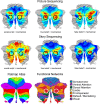Consensus Paper: Cerebellum and Social Cognition
- PMID: 32632709
- PMCID: PMC7588399
- DOI: 10.1007/s12311-020-01155-1
Consensus Paper: Cerebellum and Social Cognition
Abstract
The traditional view on the cerebellum is that it controls motor behavior. Although recent work has revealed that the cerebellum supports also nonmotor functions such as cognition and affect, only during the last 5 years it has become evident that the cerebellum also plays an important social role. This role is evident in social cognition based on interpreting goal-directed actions through the movements of individuals (social "mirroring") which is very close to its original role in motor learning, as well as in social understanding of other individuals' mental state, such as their intentions, beliefs, past behaviors, future aspirations, and personality traits (social "mentalizing"). Most of this mentalizing role is supported by the posterior cerebellum (e.g., Crus I and II). The most dominant hypothesis is that the cerebellum assists in learning and understanding social action sequences, and so facilitates social cognition by supporting optimal predictions about imminent or future social interaction and cooperation. This consensus paper brings together experts from different fields to discuss recent efforts in understanding the role of the cerebellum in social cognition, and the understanding of social behaviors and mental states by others, its effect on clinical impairments such as cerebellar ataxia and autism spectrum disorder, and how the cerebellum can become a potential target for noninvasive brain stimulation as a therapeutic intervention. We report on the most recent empirical findings and techniques for understanding and manipulating cerebellar circuits in humans. Cerebellar circuitry appears now as a key structure to elucidate social interactions.
Keywords: Body language reading; Cerebellar stimulation; Crus I/II; Innate hand-tool overlap; Mind reading; Posterior cerebellum; Social action sequences; Social cognition; Social mentalizing; Social mirroring; Stone-tool making.
Conflict of interest statement
The authors declare that they have no conflict of interest.
Figures







References
-
- Schmahmann JD, Sherman JC. The cerebellar cognitive affective syndrome. Brain. 1998;141(1998):561–579. - PubMed
-
- Van Overwalle F, Baetens K, Mariën P, Vandekerckhove M. Social cognition and the cerebellum: a meta-analysis of over 350 fMRI studies. Neuroimage. 2014;86(2014):554–572. - PubMed
-
- Schurz M, Radua J, Aichhorn M, Richlan F, Perner J. Fractionating theory of mind: a meta-analysis of functional brain imaging studies. Neurosci Biobehav Rev. 2014;42:9–34. - PubMed
Publication types
MeSH terms
Grants and funding
- NIH R15MH106957/NH/NIH HHS/United States
- R15 MH106957/MH/NIMH NIH HHS/United States
- Mille E Una Lode fellowship/University of Padua
- GR-2016-02363640/Centro universitario di ricerca e formazione per lo sviluppo competitivo delle imprese del settore vitivinicolo italiano, Università degli Studi di Firenze (IT)
- SRP57/Vrije Universiteit Brussel
LinkOut - more resources
Full Text Sources
Miscellaneous

